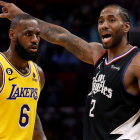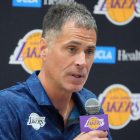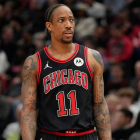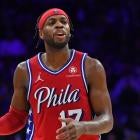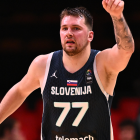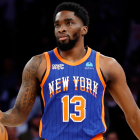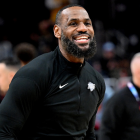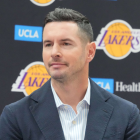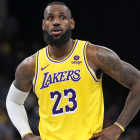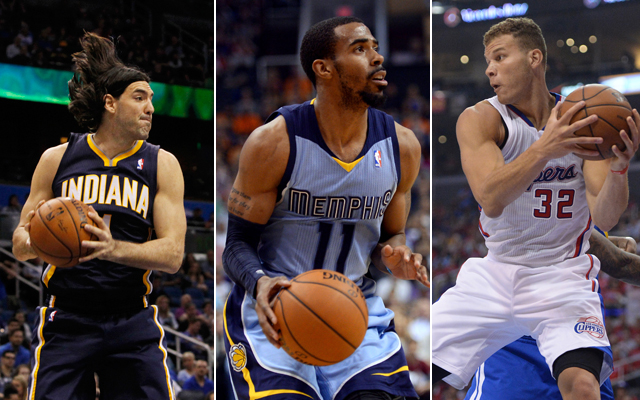
More Playoffs: Schedule | Threat Matrix | Previews: East | West | Picks
We typically see three different types of players who shine in an NBA playoff setting.
You often have your key reserve players, coming off the bench to provide a much-needed boost or keep the momentum of a good run by the starters going. Then you have leaders of the team, which typically come in the point guard role because it's their natural job description to lead a team. Then you have your shining stars, putting on a dazzling display in the face of the most scrutiny if failure comes and the most attention from the defensive game plan of the other team.
Thursday night, we'll have three games that feature these different types of playoff players.
Key Reserve: Luis Scola, Indiana Pacers
The difference between Game 1 and Game 2 for the Indiana Pacers and specifically backup power forward Luis Scola was night and day. The first game saw the Pacers embarrassed on their home floor with Scola contributing next to nothing in the process. He ended up shooting 0-of-6 from the field, scoring just two points, and the Pacers were annihilated when he was on the floor. For the game, Scola had a net rating of minus-34.0 points per 100 possessions in just over 18 minutes of play. It was the worst net rating for any Pacers player in the game.
We saw a different Scola in Game 2. It was the closest we've seen to FIBA Competition God Mode Scola that ends up lighting our summers of international basketballl tournaments on fire. The Pacers ended up rolling the Hawks in the second half and regaining some of that Blue Collar, Gold Swagger they plaster all around town. Scola scored 20 points in just over 19 minutes of action. He shot 9-of-14 from the field and had four offensive rebounds.
Here are his shot charts from the two games:
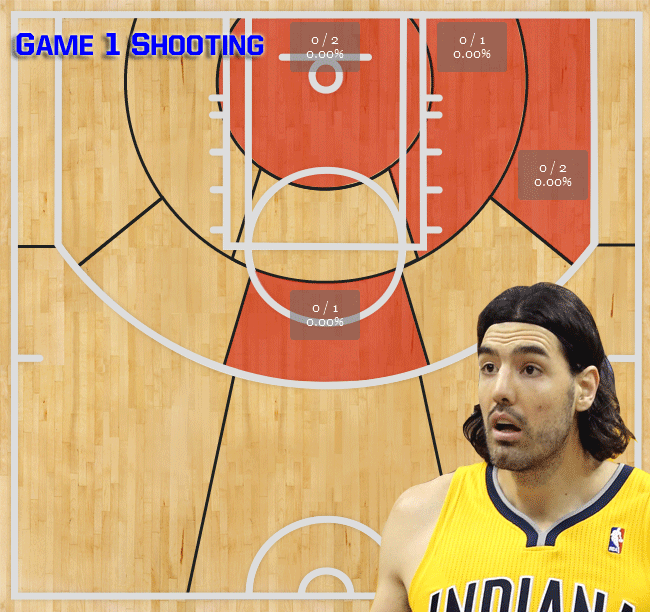
In Game 2, Scola had the highest net rating of anybody on the Pacers, posting a ridiculous plus-47.0 points per 100 possessions. It was nearly a complete reversal from the impact he had in Game 1 and then some. Scola isn't the biggest key to the Pacers winning this series and getting back on track, but adding a scoring punch from him was the plan to help right the ship with their bench unit. The Pacers are struggling to get scoring out of their big men right now and Scola is a natural scorer.
Even if he gives Indiana 75 percent of what he gave them in Game 2, the Pacers will start looking like contenders once again.
Team Leader: Mike Conley, Memphis Grizzlies
With Mike Conley leading the attack for the Memphis Grizzlies' offense, the team has been in great hands all season long. Much like with Luis Scola above, the stark difference in the impact between Game 1 and Game 2 with Conley could be the reason his team turned their first game loss into a second game victory. Other than an impressive and spirited third quarter in Game 1, the Grizzlies just got manhandled in their loss to the Oklahoma City Thunder.
With Conley on the floor in the first game, the offense sputtered. Some of that was his doing and some of it was just an entire unit playing poorly. But there aren't a lot of scorers on this Memphis team and he's the only consistent outside threat. In the Game 1 loss, the Grizzlies put up an offensive rating of 89.5 with Conley on the court. In the second game in which they won, that offensive rating jumped up to 115.6.
While his numbers in Game 1 (16 points on 6-of-16 shooting and 11 assists) were nearly identical to his Game 2 numbers (19 points on 7-of-16 shooting and 12 assists), the key to the better offense with him on the floor has a lot to do with how he worked with others. He was played in 10 of the 17 lineups Dave Joerger employed in Game 1. Only five of those lineups cracked an offensive rating of 100.0 points per 100 possessions and two of those five lineups played one minute or less together.
In Game 2, he led the lineups he was on the floor with much more consistently, as you'd hope from your point guard. He was in nine of the 14 lineups the Grizzlies put out there and only one of those nine lineups failed to cracked 100.0 in offensive rating. Most of them were above 110 points per 100 possessions. Conley led the attack so much better because no matter who he was on the floor with, he was helping create the necessary space to keep the offense flowing.
Against an offense like the Thunder's, the Grizzlies need offensive consistency and Conley is the only player who can bring it to them.
Shining Star: Blake Griffin, Los Angeles Clippers
Blake Griffin of the Los Angeles Clippers is our third example of a stark contrast from Game 1 to Game 2. The difference here is Griffin is such a big star and has such an immense impact on the game, that he was effective in both games. However, because of some questionable foul trouble, he wasn't able to stay on the court long enough in Game 1 to have the same sustained impact he had in Game 2.
Griffin set a personal playoff career-high in points in Game 2 with a 35-point performance in just 30 minutes of play. The Clippers dominated the Warriors by 40 points and we didn't really get to see how far Griffin could push it in that game because there wasn't any point to him remaining on the court. In 49 minutes in the first two games, the Clippers have a net rating of plus-31.9 points per 100 possessions with Griffin on the floor. His Game 2 net rating (plus-30.8) was actually lower than his Game 1 impact (plus-34.6).
He's making 63.3 percent of his shots in the series and is living at the rim. He's 19-of-30 from the field and 14-of-20 in the restricted area. Without Andrew Bogut on the floor for the Warriors, Griffin has no deterrent from going to the basket. In transition, in the half court, and everywhere in between, Griffin is getting to the rim and wrecking it.
David Lee is too slow to guard him. Draymond Green is too small. Jermaine O'Neal is too old.
Maybe Blake Griffin is just too good.









